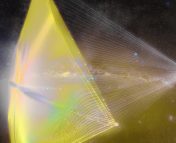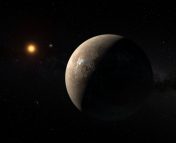Catherine Clark is a third year PhD candidate at Northern Arizona University. Catherine’s research at Lowell Observatory focuses on characterizing low-mass stars using high-resolution imaging techniques. When she’s not Fourier transforming, she enjoys climbing, yoga, and photography.
Paper Title: Is Proxima Centauri b habitable? A study of atmospheric loss
Authors: Chuanfei Dong, Manasvi Lingam, Yingjuan Ma, Ofer Cohen
First Author’s Institution: Department of Astrophysical Sciences and Princeton Plasma Physics Laboratory, Princeton University, Princeton, New Jersey
Status: Published in The Astrophysical Journal Letters, open access
Since its discovery in 2016, the planet orbiting Proxima Centauri, known as Proxima Centauri b, has fascinated astrophysicists and astronomy enthusiasts alike. Proxima Centauri is our closest neighbor at only 4.22 light-years away, which makes Proxima Centauri b the most favorable exoplanet (a planet that orbits a star other than the Sun) for exploration through concept missions like Breakthrough Starshot.
Proxima Centauri is an M-dwarf – the smallest, coolest, faintest type of star. Because these stars are so cool, their habitable zones, the regions around a star where a planet can support liquid water, are much closer to the star (see this astrobite for more information regarding the habitable zone). Planets that orbit in the habitable zones of M-dwarfs, like Proxima Centauri b, are thus much more susceptible to stellar winds.
Stellar winds are fast-moving flows of material that are ejected from stars, which can potentially erode the atmospheres of the planets that these stars host. This atmospheric erosion concerns exoplanet scientists, because planets must be able to retain an atmosphere long enough for life to form and evolve in order to be considered habitable. In our own star system, the inhospitality of modern Mars demonstrates the dangers of atmospheric loss.
In addition to supporting the formation of life in the first place, planetary atmospheres can reveal the presence of life via biosignatures – substances or phenomena that suggest the presence of a biological process indicative of life. Exoplanet scientists are currently trying to determine which biosignatures are detectable using current and future instruments, and which most definitively indicate the presence of life. Many of these proposed biosignatures require the presence of an atmosphere.
Because an enduring atmosphere is so crucial to planet habitability and the detectability of biosignatures, the authors of this paper chose to investigate whether our neighboring exoplanet is capable of maintaining an atmosphere long enough for life to form and evolve.
The authors of this paper examined two cases in their study: Case 1, in which the stellar wind pressure is at a maximum, and Case 2, in which the stellar wind pressure is at a minimum. In both instances, they considered a magnetized and unmagnetized case for Proxima Centauri b. The authors then utilized a sophisticated model originally developed for Venus and Mars, which takes into account the various chemical reactions that can take place in a planetary atmosphere.
The authors found that when stellar wind pressure is at a maximum, Proxima Centauri b and other similar M-dwarf exoplanets are generally incapable of supporting an atmosphere over billions of years in both the magnetized and unmagnetized cases. However, for lower values of stellar wind pressure, a magnetized Proxima Centauri b can potentially sustain an atmosphere over billions of years, long enough for life to develop as it has on Earth! You can see the strength of Proxima Centauri b’s magnetic field represented in Figure 1.

Though these results are exciting, most of the properties of Proxima Centauri and the planet it hosts are currently unknown, making it difficult to derive any definitive conclusions. Nevertheless, future missions such as the James Webb Space Telescope will probe these characteristics and provide additional information to determine whether Proxima Centauri is in fact our most habitable neighbor.




